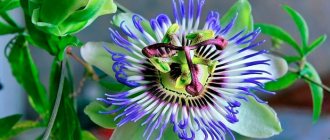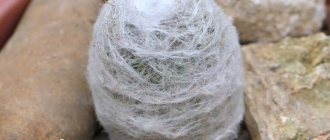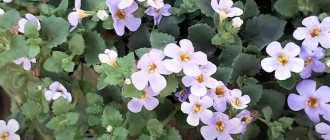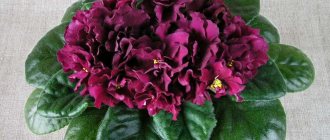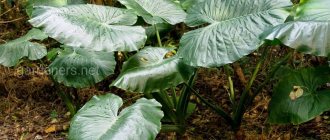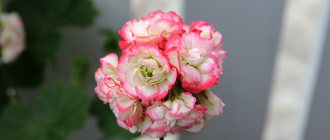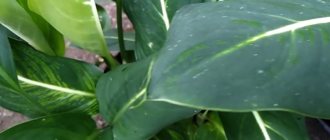The houseplant Passiflora, which came to us from the tropics of South America and Asia, is an evergreen vine with large, fantastic-looking, fragrant flowers and tasty fruits. This flower is easy to care for and has an exotic appearance. This alone is enough to make every lover of indoor flowers want to grow them at home. In this article you can get acquainted with the most beautiful and popular types of passionflower.
History of the discovery of a flower
The homeland of most passionflower species is the tropical and little-explored forests of South America; some types of flowers are also found in Asia and Madagascar. Europe became acquainted with this plant only after the conquest of the New World.
The passionflower flower has a complex and original structure - at the top of the petals there is a “crown” consisting of long scales, behind which there are large stamens. Even higher there is a pistil and 3 stigmas (see photo of edible passionflower). Because of this appearance, missionaries who came to America and the Catholic Church considered the flower to be Christ's crown of thorns and banned its study. The first description of passionflower was made only in the twentieth century.
How the flower spread across the globe
Passionflower was one of the first flowers to migrate from America to Europe in the 16th century. The first description of the plant was made by Pedro Cieza de Leon, talking about “grenadillas” originally from Colombia. At the beginning of the 17th century, church leader Giacomo Bosio became interested in the flower and began collecting drawings and descriptions of it. Later, based on them, Bosio compiled a report in which he presented the flower as an expression of Christ’s suffering. Passionflower got its name from this comparison, which translates as “passio” - suffering, and “flos” - flower. Passion flower is a translation option from Latin into Russian.
Bright red passionflower flower
Biological description
This perennial plant can grow up to 3-4 m in length; it produces very long shoots that cling to supports with tendrils. The leaves are large, consisting of 3-5 lobes. The fruit of passionflower is a juicy multi-seeded berry; there are up to 60 edible species of passionflower, many of them are even grown as fruit plants.
The most famous and popular edible varieties of passionflower:
- Passion fruit.
- Granadilla.
- Maestro.
- Galaxy et al.
Common species in home culture
Blue passionflower (P. cearulea) . The very first beautifully flowering species that became widespread in Europe.
Experts recommend it primarily because of its extremely decorative varieties with flowers that are colored blue, purple, white and even pink.
Passiflora cearulea
Passionflower incarnata (Passiflora incarnata) - very similar to the previous species, but with even larger flowers of white, soft pink, scarlet or dark red color.
The fleshy, edible fruits set in July and ripen in the fall.
Known varieties:
- orange-yellow "Sunburst"
- dark purple “Inspiration”,
- pink-red “Raspberry strudel”,
- dark red variety "Lady Margaret",
- pink variety "Victoria".
Variety "Victoria"
Passionflower (Passiflora edulis) or passion fruit with tasty fruits, the color of which varies from dark purple to light yellow.
Passion fruit variety "McCain"
Sweet granadilla or passionflower (P. ligularis) is another widespread species native to the Andean mountains. Outside its range, it grows in the tropical mountains of Africa, where this plant is known as granadilla.
At home, passionflower granadilla is cultivated mainly for its tasty fruits.
Granadilla
Passiflora vitifolia or grape-leaved (Passiflora vitifolia) with large dark green leaves similar to grapes and large flowers of red or wine color. The fruits are small and sour.
Vitifolia
Maintenance and care of the plant
Edible passionflower (or passion fruit) is a fast-growing vine that can be planted both in open ground and at home. The main condition for successful growth is sufficient lighting, so it cannot be grown in the shade or under a dense tree crown.
Optimal temperature for growth: +18...+24 ˚С, at higher temperatures the leaves begin to turn yellow and dry out, the number of buds decreases, and the death of the plant is possible. In winter, during the dormant period, it is kept at +12…+18 ˚С.
The soil for passionflower is light, well permeable to air, for which sand or peat is added to it.
The flower requires frequent watering during the period of growth and flowering (from spring to late autumn), the soil should always be slightly moist, in the summer it is watered every other day. During the dormant period in winter, watering is done once a week or even less often. Passionflower is demanding on air humidity; in the summer it should be sprayed frequently, but the sun's rays must not burn the leaves through the drops.
Plants are fertilized twice a month using complex mineral mixtures. You can use liquid flower fertilizer, but diluted in half.
Passionflower does not tolerate drafts, but loves frequent ventilation. When planting, you should take into account the presence of supports along which the vine will grow upward. The plant must be pruned frequently, especially shoots after flowering, which are cut off completely. In spring, pruning is done to 1/3 of the length, since flowers will only be placed on fresh shoots.
Conditions of detention
Passion flower is an exotic plant for Russia. This inhabitant of humid subtropical forests requires certain conditions for development, flowering and fruiting.
Lighting
Passion flower prefers well-lit places. It grows better in sun than in partial shade. He is not afraid of direct light. Shaded places are contraindicated for him.
Lighting Features:
- In the summer, it is useful to take the vine out into the fresh air. It is advisable to place it in a sunny and warm place.
- In winter, the vine needs additional lighting. It can be created by placing a phytolamp next to the plant.
- The best place to place the liana is the eastern and western windows. They are evenly illuminated throughout the day, but there are no scorching rays on them, like on southern windows.
- A slight shadow is allowed, but to the detriment of flowering. Shading reduces the intensity and density of flowering.
During the cold period, the plant receives little light and gradually gets used to such conditions. When it gets warmer and daylight hours increase, it is necessary to gradually accustom passionflower to more intense and longer-lasting light. If you take the plant out into the sun without preparation, it will get sunburned.
Temperature
Passion flower is thermophilic, but does not like heat and dryness. It grows best in moderate temperatures. The optimal range is from +20 to +25°C. In winter, the plant adapts to harsher conditions. During this period, the vine needs a temperature of +13 to +18°C.
Humidity
The liana comes from the subtropics, so it loves high humidity. She feels uncomfortable in dry air. To meet the needs of passionflower in a humid environment, it is periodically sprayed with water. Spraying is especially necessary in winter when the heating is on in the house.
To raise the humidity level, porous materials are placed in the tray - peat, moistened expanded clay or other porous materials. It is not permissible for the bottom of the container in which the vine grows to come into contact with the water flowing into the pan.
In dry air, the South American vine gets sick and withers. The growth of stems, tendrils and leaves slows down, and the inflorescences fall off.
Attention!
Passionflower should be sprayed and watered with water at room temperature. Cold water is contraindicated for the vine.
Propagation of passionflower by cuttings
Edible passionflower can be propagated in several ways, the easiest of which is by cuttings. The apical cuttings that have buds are cut to a length of up to 10 cm in the summer, and then rooted in the soil in a warm room (+20...+25 ˚С). To prepare the soil mixture when planting, take 3 parts of leaf soil, 2 - humus, 2 - turf, 1 - sand.
Immediately before planting, they are treated with root, then the pot with cuttings is covered with film, and within 1 month the cuttings take root. You can put the cuttings in water, adding a piece of charcoal, for 1.5-2 months. roots should appear, but the water should not be changed.
During the growing season, you can also propagate by mustache.
Propagation of passionflower by seeds
Propagation by seeds is a longer process than by cuttings. In addition, very often the seeds do not germinate well due to long storage (sometimes several months). With this method, certain rules must be followed:
- growing edible passionflower from seeds begins in February;
- The soil mixture must be disinfected before planting: roast in the oven for 10 minutes. at 200 ˚С;
- the seeds are sown in the soil to a depth of 1 cm. Then the container is covered with film or glass, the room temperature should be +22...+24 ˚С. When the first leaves appear, pick them into separate pots with a diameter of more than 7 cm;
- Edible passionflower seeds have a hard shell, so to soften it they do scarification - lightly rub them with sandpaper on both sides;
- then soak the seeds for a day in milk or in a solution of citrus juice (lemon or orange);
- only then planted in a container or peat cups;
- Every day the container needs to be ventilated, for which the film is removed for 5 minutes;
- the soil is moistened as it dries by spraying;
- As soon as the sprouts appear, the film is removed and the container must be moved to a place with good lighting.
Reviews about growing
Valentina. Sochi city .
If you are just starting to grow a vine, you should first choose the right variety. Only after you decide what kind of care is required for the selected variety can you purchase a plant. It may turn out that it is impossible to create conditions for the vine you like. It's not worth the risk. Choose passionflower so that it feels comfortable in your home. The correct location of the flower in the apartment greatly affects the quality of flowering and fruit formation. If cultivation is carried out to produce fruit, then I recommend purchasing “edible” passionflower. The Edulis variety has the most pleasant taste.
Marina. Moscow region.
I prefer to propagate passionflower by seeds. The method is very simple. I did not treat the seeds with sandpaper. I just soaked it in water and left it for a day. Germination is 100%. True, some shoots turned out to be quite weak and lagged behind in development. I had to remove them. I read that the flowers will not appear soon, but anyway, the plant decorates my apartment. Liana in the house is exotic. In the spring you need to do pruning. Lots of fresh shoots appear. I placed a vine near the south window. Additionally, I installed lamps for illumination to speed up development.
Planting and flowering passionflower
This plant is a perennial; it is replanted once a year in the spring. When planting a small plant in the first year, it should be covered with a glass jar for 2 weeks. In the first year, passionflower forms the basis of the future vine, growing the main shoots, usually up to 1.5 m long. At the same time, it definitely needs support to gain a foothold.
In autumn, when the temperature begins to drop below +15 ˚С, the plant must be moved to a room where the temperature can be maintained at +13…+16 ˚С. If the room is hot, the vine begins to go bald and loses its leaves.
In the spring of the second year, you should prune last year's long shoots by a third of the length, taking into account that the flowers will form on fresh shoots. Passionflower blooms almost the entire summer season from June to October, but each flower lives only 1 day.
It is difficult to grow fruits indoors. To get them, you must have at least 2 plants of the same species, since they are cross-pollinated. Due to mismatched flowering on these plants, pollination may not occur. Fruits of various plant species usually ripen within 2-3.5 months.
Let's look at different varieties of edible passionflowers.
What does passionflower look like?
Passionflower is a perennial or annual climbing plant that, in favorable climatic conditions, can grow up to 8 meters. The stem of the plant can twine around a tree or spread along the ground. It is covered with alternately arranged leaves ranging from 7 to 18 cm in length. The outer side of the leaves is dark and smooth, the inner side is somewhat lighter. Tendrils and flowers ranging in size from 6 to 13 cm on elongated pedicels are attached to the leaf axils. A passionflower flower in its natural environment can have a pale to rich lilac hue. Plants bred through the selection process have flowers that come in a rich range of colors - they can be white, red, pinkish, blue, light blue. The flowers smell very good; in some species, flowering lasts 2-3 months, in others - several days. Then, in place of the flowers, green-yellow oval-shaped fruits grow, about 6 cm in length. Flowering lasts from June to September, fruits ripen in August-October. The seeds of the plant are black and have a flattened, ovoid shape.
Types of passionflower
Passion fruit or Granadilla (Passiflora edulis) is the most common species, native to Uruguay, Brazil, and Argentina. In cultivation it grows up to 5-8 m, has matte three-lobed leaves. There are two varieties of it: with yellow fruits and purple ones. The flowers are very large (6-8 cm) light purple, and the fruits are round in shape up to 6 cm in size. Drinks and sweets are prepared from them, and added to tea.
Banana passionflower (Passiflora mollissima) grows naturally in Bolivia, Venezuela and Colombia. The flowers are pink, up to 12 cm in size, the fruits emit a pleasant aroma. Of all the species, banana passionflower is the most cold-resistant, bearing fruit in the first year.
Passiflora edible Galaxy is a perennial climbing plant, vines grow up to 4.5 m long, flowers up to 12 cm in size are white and pink. The fruits are brown-red and have a pleasant aroma.
The largest in terms of fruit size and stem length - Passiflora quadrangularis - grows up to 15 m in length, the flowers are also large, up to 15 cm in diameter, the fruits are large, oval-shaped up to 30 cm, have a thick peel, and inside there is sweet juicy pulp . In the middle zone, such a plant can only be grown in greenhouse conditions.
Edible passionflower Maestro is one of the popular and widespread varieties in Russia, which is successfully used by gardeners for growing indoors and outdoors.
Apple-shaped passionflower (Passiflora maliformis) or Chulyupa is a vine with a tree-like stem up to 10 m long. Its fruits are up to 5 cm in size and contain sweet, aromatic gray or pale orange pulp with black seeds. The pulp is used in making drinks. Plantings of this species are grown in Brazil and Ecuador for their edible fruits.
The history of passionflower
Passionflower (passion flower) belongs to the "Passionflower" family, most likely due to the amazing and peculiar beauty of the entire plant, namely the flower. Brazil can rightfully be considered the birthplace of the plant. Today this plant is successfully grown in South Africa, Australia and South America. One of the first New World plants to reach Europe. Passionflower was discovered back in 1590. The plant grew everywhere. The first use of passionflower is described as decoration. The flowers of this plant were woven into wreaths, as they retained their freshness for a long time, like no other flower after cutting, and did not wither. The name of this plant was given by the monks, who saw in it a resemblance to the crown of thorns of Christ. Although the plant is very heat-loving, and its homeland is warm, southern countries, subject to certain growing rules, it grows well in the fertile lands of Central Europe. Passionflower is also grown in Ukraine.
Diseases and pests of passionflower
Edible passionflower can suffer from attacks by spider mites, aphids, mealybugs and whiteflies. You can protect the plant with the help of “Fitoverma” or “Aktara”; to destroy scale insects, preparations containing cypermethrin (Arrivo, Inta-vir) are used.
Infectious diseases that can threaten the plant are root rot, late blight, ring and brown spot, scab, fusarium, and very rarely, yellow mosaic virus. It is very rare to cure a diseased plant, so it is destroyed along with the pot.
Care errors. What to do to correct the situation
| Problems | Causes | Solutions |
| The tips of the leaves turn brown | Too dry air, reduce watering. | Set air humidity control. Bring watering to the recommended rate. |
| The leaves acquire a soft consistency and curl | The temperature regime is violated. Low temperature. | Bring the temperature to normal. |
| Leaves turn yellow and fall off | Insufficient watering. Low temperature. | Bring indicators in accordance with requirements. |
| Slow development of the vine | Lack of nutrition. | Fertilizing with complex fertilizers. |
| Thinning leaves and shoots | Violation of light and temperature conditions. | Check the lighting. Increase the amount of nutrients. |
| The base of the stem rots | Excessive watering. | Check drainage efficiency and reduce watering. |
| Passionflower doesn't bloom | Diseases and various types of pests. | Prevention and timely disposal of diseases and insects. |
Medicinal properties of passionflower
Some types of passion flowers also have important medicinal value. Even the ancient Incas used passionflower as a soothing tea. The main healing effect of passionflower is sedative, improving the quality and duration of sleep without any negative consequences. The plant is used to treat diseases of the nervous system, helps with insomnia, depression, epilepsy, etc.
Also, medications prepared from this plant have antispasmodic, anti-inflammatory, anticonvulsant and analgesic effects, help improve memory, increase performance and potency. Another unique effect of passionflower - compensation for the effects of amphetamine - is used with great success to cure drug addiction and alcoholism.
The most valuable species from a medical point of view is Passiflora incarnata or apricot, which grows into a very long vine up to 10 m. The flowers are bright purple, and the fruits have a lemony tint, the size of a plum, and taste sweet and sour. The medicine “passiflora extract” is made from its aerial parts, which has a calming effect and is prescribed for diseases of the nervous and cardiovascular systems. The fruits have a very interesting smell, similar to the aroma of lilac.
Areas of application
Passionflower is used in various fields of activity, but mainly in medicine and cosmetology. Preparations and dietary supplements are produced from the plant, which are used in the treatment of addiction to potent substances, as well as to eliminate problems with the nervous system. Thanks to its beautiful flowers, the plant is grown at home and used to decorate greenhouses and parks. It is often bred in nurseries and botanical gardens.
Passion flower extract
Medicinal use
In modern medicine, the upper parts of passionflower are used to create medicines and extracts. The latter has a pronounced sedative effect and helps in the treatment of diseases of the central nervous system. Medicines from passionflower are used in the treatment of tetanus and epilepsy. Flowers help relieve migraines and pain during menstruation.
Traditional medicine offers a recipe for passionflower tea. To prepare it, you need to take 1 tsp. flowers and pour a glass of boiling water over them, cover with something and let sit for about 10 minutes. Tea helps with insomnia, calms you down, and helps you sleep better.
To normalize the pressure, prepare the following tincture: put 70 g of dried raw materials in a thermos, pour in 1 liter of boiling water, close the lid tightly and leave for 7 hours. At the end of the period, the liquid is filtered. The product should be taken 30 ml after meals.
Passionflower-based cosmetics
For cosmetology, passionflower oil and extract containing useful substances are valuable. The oil is suitable for the care of cracked and dry skin; it moisturizes, softens and nourishes the tissues. Passionflower also helps eliminate itching from insect bites, treats inflamed tissues, relaxes muscles and protects against the effects of sunlight.
INTERESTING FACT. After applying passionflower oil to the skin, it is quickly absorbed and does not leave a greasy film.
Using passion fruit for food
In our country, the fruits of edible passionflower (passion fruit and other types) can only be found in additives to yoghurt, ice cream or juice. Very rarely, a piece of the fruit can be found in tropical tea blends.
The pulp of this fruit is very tasty and sweet; in its homeland it is consumed raw, mixed with sugar and water, and for making jams, jellies and sorbets. Often pieces of this fruit are added to curd desserts and cakes.
Sweet juice and jam can be used in preparing meat and fish dishes; the fruit tastes best with nuts, apples, cinnamon and pear.
However, caution should be exercised, because some varieties (for example, Azure passionflower) contain a small percentage of cyanide, while some others contain weaker toxic substances harmful to human health.

